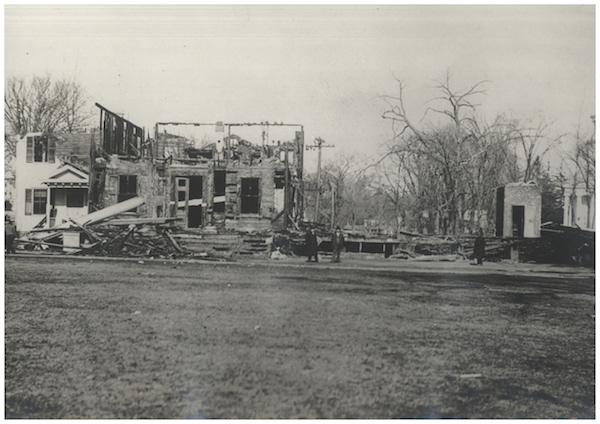


Hostile Indians set fire to the Burnt Plains area in 1646 leading the Milford settlers to worry about a shortage of building timbers. One night in the winter of 1757-8, the East Town House or 2nd Town Hall caught fire and burned to the ground as British soldiers got drunk there 20 years before the American Revolution The British government paid the town fifty pounds towards constructing a third building for their administrators. (If adjusted for the dollar conversion rate and inflation this would be about the equivalent of $10,600.00)
A carriage factory on Cherry Street was destroyed by fire around the time Milford's first fire company was founded in 1838 as the Milford Fire Company. Members contributed seventy-five cents toward the purchase their first fire engine Dissatisfied with several fire engines that did not meet Milford's needs, a group of local men built one themselves the next year. A small building in the rear of the Town Hall became Milford's first fireman meetinghouse in 1840. The Wepawaug Engine Company No. 1. fined firefighters 25 cents each time they reported without their equipment in 1851, the secretary of the company was paid an annual salary of seventy-five cents.
The Wepawaug Company felt the duly elected officers of the company were better qualified than an outsider upon the appointment of a fire warden by the town officials in 1852. They accepted the fire warden 2 weeks later when he organized Bucket Brigades. Erection of a new engine house was completed in the summer of 1855. An engine from the New Haven Fire Department on trial was purchased in 1857 despite its water pump not being very powerful. The company has been named The Arctic Engine Company No. 1, after this engine since on March 1, 1858.
The volunteer fire company threatened to quit if the town did not replace the old fire engine after a May 9, 1882 fire at Buck's Drug Store required use of a bucket brigade. Even with the new engine, some parts of Milford were beyond reach including a closed Charles Island hotel that was destroyed on August 7, 1884. Horses pulled the engine in 1892 with bicycles getting the volunteers to the scene. An electric fire-alarm system begun in 1898 was underfunded. Several shoreline fires between 1896 to 1907 prompted the formation of The Woodmont Fire Company in 1897, the Walnut Beach Company in 1905, the Fort Trumbull Beach Company in 1909, the Devon Volunteer Fire Department in 1910, and the Myrtle Beach Fire Company in 1912.
The 4th Town Hall burned down on the morning of February 19, 1915. A stray cat woke transients in the basement jail who avoided the flames and alerted the town of the fire. A town official's instructions for a firefighter to keep a hose on the fire-proof vault saved town records and the First Church's silver communion service. It stands alone in visibile in pictures or the remains of the town building. A high wind hindered controlling the estimated $50,000 (almost $1 million in current dollars) damage to the structure. Court cases previously held in the old Town Hall were moved to the Saint Peter's parish house while the present & current 5th Town Hall was being erected on the same site as the previous hall on June 17, 1916. Later in 1915, a new central firehouse was built on Factory Lane near Broad Street.
To address the growing needs of public safety, the next year, 1917, Milford consolidated the fire departments and hired its first building inspector. The volunteer companies turned over their apparatus to the new Board pledging themselves to abide by the rules established. A modern concrete fire station for the Devon Hose Company was opened on December 9, 1918 featuring a truck with a chemical tank. The Myrtle Beach and Walnut Beach Fire Companies were consolidated in 1919 into a new firehouse on Naugatuck Avenue at Stowe Avenue. Ironically in February 1920 the Fort Trumbull Beach Fire Company No. 2 firehouse burned down necessitating a temporary firehouse until the Charles Street structure was completed in 1924.
The Arctic Fire Department moved into a new two-story, red brick building with white trim Central Fire Station on July 13, 1929. Hoses could be dried in the basement near two bowling alleys and a banquet hall with a kitchen.
In the early 1970's Doris Gagnon's car was one of the arson cases in the almost weekly fires of the houses under eminent domain proceedings for Silver Sands State Park or at the adjoining city dump. Large fires in the decade caused more than $6,000,000.00 in damages ($36m adjusted for inflation) to the Furniture Transport warehouse on March 11, 1970 and destroyed one end of the Connecticut Post Mall on May 22, 1976.